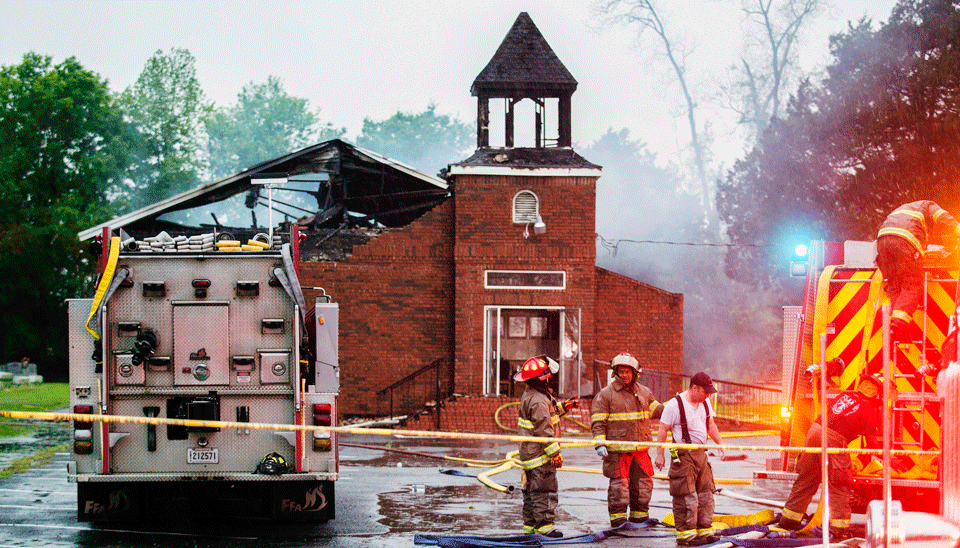
Some positive news has come out of the tragic burning of the Notre Dame Cathedral fire earlier this week. After three of France’s richest families pledged to donate more than $600 million to rebuild the religious and cultural icon, the spotlight was turned on similar symbols of faith needing assistance. Three historically Black Louisiana churches that were burned down in recent arson attacks have seen a monumental increase in financial support in the wake of the Notre Dame blaze. The churches have amassed over $1.8 million in donations since Tuesday, April 16.
Over the course of ten days, beginning on March 26 of this year, Mount Pleasant Baptist Church, St. Mary’s Baptist Church, and Greater Union Baptist Church were all burned down in gasoline fires. Since then, it has been revealed that these attacks were most likely fueled by racial hate and bigotry, as police have arrested and charged Holden Matthews, the 21-year-old son of a sheriff’s deputy, with the crime. Each of the churches were well over a hundred years old.
The Notre Dame Cathedral, over 800 years old, has a long history. It survived the French Revolution and two World Wars. Adolf Hitler, the very personification of hate and fascism, ordered the burning of Paris, including the cathedral, during World World II, but even then the church was spared. Just as the cathedral is a cornerstone of history, a symbol of peace and strife, so too are the Black churches of the United States.
Nineteenth century Black churches not only served as places of religious faith, but doubled as centers for the secular needs of their community. During Radical Reconstruction, they served as political halls. During the Civil Rights era, they were seen as social and political power bases for the Black community. Faith leaders who saw their ministry as a way to preach the words of equality and liberation for all, such as the Baptist preacher and activist Martin Luther King Jr., emerged from the Black church. Just as these institutions became involved in the fight for racial equality, they also became targets for hate.
Since the 1950s alone, there have been at least one hundred attacks on Black churches. These places of worship have often been targets of domestic terrorism by hate groups, such as the Klu Klux Klan, and those that adhere to the dangerous rhetoric of racism and white supremacy. The most infamous attack on a Black church occurred on September 15, 1963. The Sixteenth Street Baptist Church in Birmingham, Alabama, was firebombed, resulting in the deaths of four young Black girls. Many Black churches serve as cultural and religious icons, speaking to the complex history of racial unity in the United States.
While the world watched the burning of the Notre Dame Cathedral with sadness and shock, President Donald Trump and Vice President Mike Pence immediately spoke words of support and offers of assistance to France on social media. Pence remarked, “It is heartbreaking to see a house of God in flames. Our thoughts and prayers are with the firefighters on the scene and all the people of Paris.” Yet, neither the president nor the vice president have given this level of attention to the three burned churches in Louisiana. It has taken two weeks for a representative of Pence to give an official statement to the press on the Louisiana fires.
The cause for the fire at the cathedral is still under investigation, but the catalyst for the fires at the Black churches is very clear. That would be the hate and bigotry that has plagued and divided the nation for some time, and has been trumped up, so to speak, since the 2016 election. The FBI’s 2018 annual “Hate Crime Statistics” report concluded that there was a 17% increase in hate crimes from 2016 to 2017. Using recent data from the Anti-Defamation League, The Washington Post reported that counties that hosted Donald Trump political rallies in 2016 saw a 226% increase in hate crimes over comparable counties that did not host Trump rallies.
It can be seen as a silver lining in the midst of tragedy that attention was brought to the plight of the three Black historic churches. Yet, it goes to show the lack of mainstream attention given to communities still in need of assistance, especially from a United States government that is more than capable of offering something beyond platitudes of hope and support on social media. Flint, Michigan is still dealing with a clean water crisis, as residents continue to rely on bottled water donations, and the people of Puerto Rico are still in need of relief from the devastation of Hurricane Maria.
All this is still ongoing while Trump press secretary Sarah Huckabee Sanders gives a statement on behalf of the administration occupying the White House that the U.S. will offer “assistance in the rehabilitation [to France] of this irreplaceable symbol of Western civilization.”
One could go into a deeper analysis of what and whom the term “Western civilization” is associated with, in contrast to the people of color in Flint and Puerto Rico, but that can be saved for another piece. If nothing else, Sanders’ statement on Notre Dame, and Trump’s lack of a statement on the Black churches of Louisiana, shows the disconnect between the priorities of this government and the needs of the American people.








